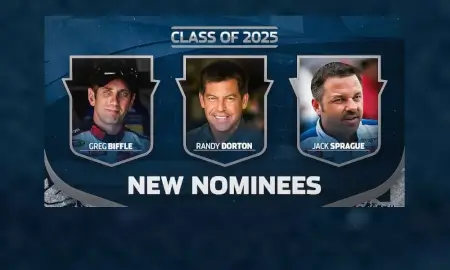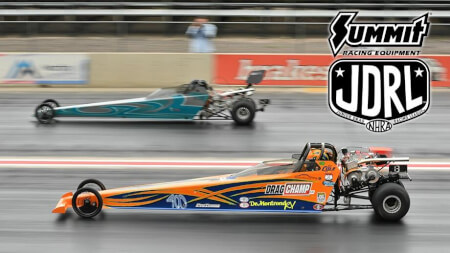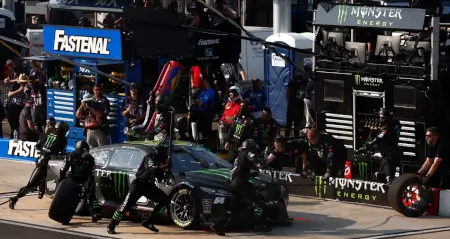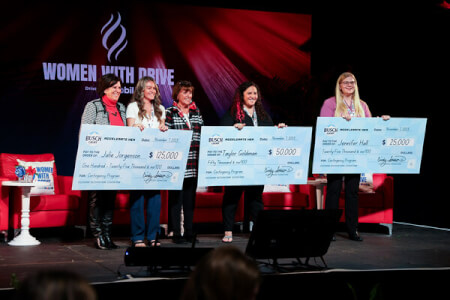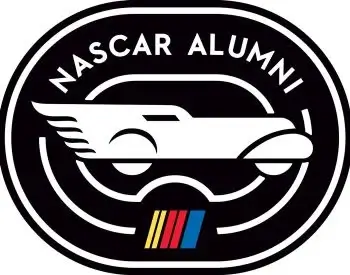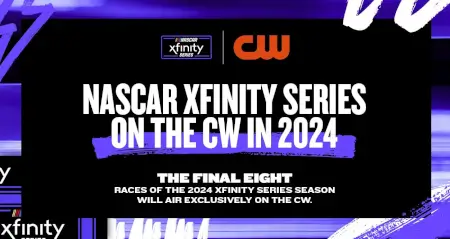January 24th 2024
NASCAR reveals tweaks to qualifying procedures for 2024
Qualifying procedures for the NASCAR Cup Series will receive an adjustment in 2024, officials revealed Tuesday at the sanctioning body’s Research & Development Center.
Each race’s 36-plus entrants will continue to be split into two groups for time-trial qualification, with the fastest five drivers from each group advancing to the pole round and setting the top 10 starting positions for the main event. That hasn’t changed. What will change is the manner in which positions 11-40 are determined.
Qualifying procedures for the NASCAR Cup Series will receive an adjustment in 2024, officials revealed Tuesday at the sanctioning body’s Research & Development Center.
Qualifying procedures for the NASCAR Cup Series will receive an adjustment in 2024, officials revealed Tuesday at the sanctioning body’s Research & Development Center.
Each race’s 36-plus entrants will continue to be split into two groups for time-trial qualification, with the fastest five drivers from each group advancing to the pole round and setting the top 10 starting positions for the main event. That hasn’t changed. What will change is the manner in which positions 11-40 are determined.
On the Move: Changes to know for the 2024 season
Previously, the cars that finished outside the top five in the two groups were seeded 11-40 based on their fastest qualifying lap, regardless of which group the drivers were in.
Beginning in 2024 – and with the exception of the Daytona 500, which has its own unique qualifying procedure – cars that do not advance from Group A will determine the outside row for starting positions 11-40, while the remaining cars from Group B will determine the inside row.
For superspeedways, there will be no groups during qualifying procedures. There will be two rounds, with the fastest 10 drivers advancing from the first round and the best time from Round 2 taking the pole.
Officials landed upon this alteration after feedback from the industry. Because track conditions can change throughout the course of a qualifying session, the goal of defining what row a driver may start from is to limit those possible variances.
Group assignments will continue to be determined by performance metrics, a total number based on the previous event: 15% of a fastest lap time position, 25% of the driver’s final race finish position, 25% of the owner’s final race finish position and 35% of the owner points position, according to the NASCAR Rule Book. Any vehicles entered with a different driver for the event than the previous race, per the rule book, will have its driver-based numbers (fastest lap and finish position) set at 41. Driver metrics are not transferable to another vehicle.
In other news and notes discussed at Tuesday’s competition briefing:
— Next Gen towing will have its first major overhaul in Cup Series qualifying beginning in 2024. Officials have worked with teams and drivers to determine solutions to assist a vehicle stranded with flat tires back to pit road without destroying the underbody of the machine, a particularly sensitive and expensive piece of the vehicle. If a car spins in qualifying and the driver is unable to drive the car back to pit road, a tow truck with a dolly will be sent to retrieve the vehicle and lift it off the ground. Through testing, officials determined they are able to tow the car at speeds up to 70 mph.
For now, towing will remain limited to qualifying and not the race. Qualifying allows more time for the safety crew to retrieve the vehicle while this process is in its early phase, while attempting this during a race may extend a caution period longer than what fans and officials would prefer.
— Wet-weather tires will return to all road courses and most ovals 1 mile in length or shorter in 2024, with the exception of the high-banked concrete tracks of Bristol Motor Speedway and Dover Motor Speedway. This year, the only requirements on those vehicles at ovals will be a defogger. Lights, wiper blades and rear flaps will be additionally required at all road courses, but none will be mandated at the short ovals. NASCAR first used the wet-weather tires in a NASCAR Craftsman Truck Series race at Martinsville in the spring and again for the NASCAR Cup Series during All-Star Weekend at North Wilkesboro Speedway.
— Less grass is in Daytona International Speedway’s future. A portion of grass has already been removed and replaced with fresh pavement, all following Ryan Preece’s tumble down the superstretch in the August 2023 NASCAR Cup Series contest. In reviewing the aftermath of Preece’s crash, including a reconstruction of the incident, officials determined the grass indeed had a negative impact on the car, both creating lift and grabbing the vehicle as it rolled upside down against the lawn. After the 2024 Daytona 500, the remaining stretch on the backstretch will be paved to the middle of Turn 3.
The rumble strips currently in place for IMSA’s Rolex 24 at Daytona will also be removed, set to be replaced by concrete pads where variable rumble strips may be put into place for road racing but removed for oval events.
— Using data collected from drivers’ mouthguards after the 2023 contest at Watkins Glen, the sanctioning body has determined to remove the steep curbing through the bus-stop chicane at the 2.45-mile road course. Curb-hopping triggered notable spikes in forces the drivers underwent each time they raced through the inner loop. Like Daytona, those curbs will be removed and replaced with contact pads. Different temporary strips — whether flat, an inch tall or otherwise — will be tested during a Goodyear tire test at the facility on June 26-27.
Recessed rumble strips will also be implemented in the run-off section of Turn 1, an addition made in effort to limit drivers’ use of the extra pavement on driver-left of the 90-degree right-handed turn.
— NASCAR Xfinity Series director Wayne Auton said that teams will have a limit on the amount and details of their backup cars for each race, with both restrictions meant as a cost-saving measure. Organizations with one or two teams are permitted to have one reserve car at each event, and that car can be fully prepared. Organizations with three or four teams may have two backup cars; one of those cars may be fully prepared, but there can only be one engine between the two.
Auton said that the backup-car restrictions will not be in place in two logistics scenarios – when qualifying and the race are separated by only two hours or less, and potentially in circumstances with West Coast races back-to-back (Portland to Sonoma in June, for instance) where the competition officials will work with the teams to mitigate the logistical hurdles as needed.
Additionally, those backup cars will not have a full vinyl wrap as another economic plus. Each team will designate a solid color for their reserve cars at the start of the season, and decals will be added if a backup car is deployed. Auton said the measures came in collaboration with and at the suggestion of teams in the Xfinity Series garage.
MORE:
— Cup Series teams will be permitted to have lighted, LED signage attached to their pit boxes, providing another showcase spot for sponsorship placement. Cup Series director Brad Moran said that rules and guidelines about the signboards are expected to be made final next week, but that the expected measurement is 42 inches tall by the width of the pit box. Competition officials will also mandate dimmer switches and require that the display not change or move during green-flag racing.
“Just Cup only and again, for obvious reasons. It’s probably a fairly substantial expense for the teams and the industry, but as well, it’s also an opportunity for them to increase their sponsorship and have more to sell to their sponsors,” Moran said. “At the highest level, we feel it’s a good opportunity for the teams to create some new income with it and give more back to their sponsors.”
— Xfinity and Craftsman Truck Series pit crews will move to a smaller fuel can this season, dropping the capacity from 11 gallons to nine. With the reduction in weight – approximately 15-16 pounds, Auton said – teams would be able to have a less specialized athlete to fuel the vehicles. Auton said he expected delivery of approximately 100 new fuel cans later Tuesday, which would be certified for competition use. He also indicated that teams could reduce the size of existing fuel cans, but that those retrofitted cans would need to fit the competition department’s templates.
— No changes are expected to the inspection process or the penalty and deterrence model for 2024, but that the Cup Series will have some new equipment. Moran said a “much beefier” upgraded version of the underbody scanner will have its own station near the scales, and that other equipment has been refurbished for this season.
Competition officials also said plans are underway to build out a remote race control platform in NASCAR’s new production facility in Concord, North Carolina. Scott Miller, NASCAR’s former senior vice president of competition and current competition strategist, will head up the project, which will create a “war room” to supplement the at-track officiating process and provide a training ground for future race-control officials.
— NASCAR officials have made updates to the muffler configurations, which will be run at the Busch Light Clash at the Coliseum in Los Angeles (Feb. 4) and at the Chicago Street Course (July 7). Technical changes have been made underneath the car to help reduce heat and noise in the cockpit, and those enhancements were tested for driver comfort and durability last month at Phoenix Raceway.
— Stage breaks are back for each road race on the 2024 NASCAR Cup Series schedule, meaning caution periods will return at the conclusion of the first and second stages. The sanctioning body began 2023 without stage breaks at road courses, hoping a strategy element would create more excitement throughout the course of the event. But one-caution races at both the Indianapolis Motor Speedway road course and Watkins Glen International produced races that officially lasted 2 hours, 10 minutes or less. Stage breaks were subsequently brought back for the Charlotte Motor Speedway road course in October to close the season. Shifting back to stage breaks at all tracks brings consistency across the 36-race schedule of the Cup Series while hopefully adding more on-track excitement to the field.







